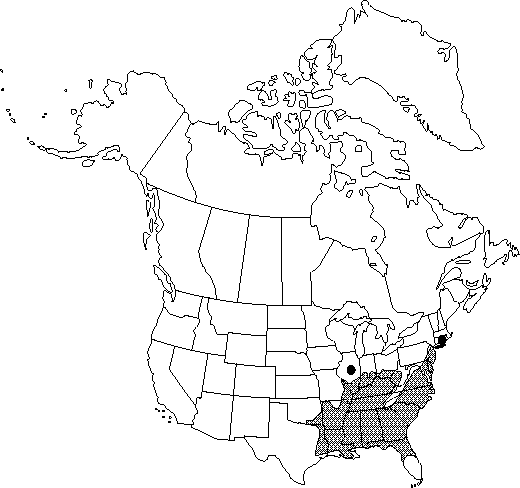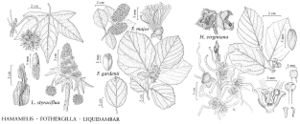Liquidambar styraciflua
Sp. Pl. 2: 999. 1753.
Trees, to 41 m. Leaves: stipules linear-lanceolate, 3-4 mm, early deciduous, leaving 2 stipular scars adaxially near base of petiole; petioles (44-) 60-100 (-150) mm. Leaf-blade palmately lobed, main lobes sometimes again dentate-lobed, 7-19 (-25) × 4.4-16 cm; surfaces glabrous, except young leaves hairy on veins and main vein-axils at base with persistent reddish-brown simple hairs. Staminate flowers in pedunculate clusters, 3-6 cm; perianth absent; stamens 4-8 (-10) per flower, 150-176 (-300) per cluster, falling after anthesis. Pistillate flowers without perianth; hypanthium disclike, with 5-8 staminodes around cycle of disc lobes; ovary (1-) 2-locular; styles 2; stigmas introrsely curved. Capsular heads brown at maturity, globose, 2.5-4 cm diam. (including indurate styles). Seeds apically winged, 8-10 mm, marked with resin ducts; aborted seeds brownish, 1-2 mm, unwinged, irregular, resembling sawdust. 2n = 32.
Phenology: Flowering spring (Mar–May).
Habitat: Fields, woodlands, flood plains, low hammocks, swamps, riverbanks
Elevation: 0-800 m
Distribution

Ala., Ark., Conn., Del., D.C., Fla., Ga., Ill., Ind., Ky., La., Md., Miss., Mo., N.J., N.Y., N.C., Ohio, Okla., Pa., S.C., Tenn., Tex., Va., W.Va., Mexico, Central America (Belize and Honduras to Nicaragua)
Discussion
The leaves of Liquidambar styraciflua, fragrant when bruised, turn deep red to crimson in autumn. Although leaf variation is common in L. styraciflua, this deviation is randomly distributed and without any definable geographic correlation. Liquidambar styraciflua is often cultivated; a number of cultivars have been introduced in cultivation.
Liquidambar styraciflua was well known as a medicinal plant by Native Americans. Cherokee, Choctaw, Houma, Koasati, and Rappahannock tribes used it in various ways, especially the gum, bark, and root, as an antidiarrheal, dermatological aid, gynecological aid, sedative, febrifuge, and for related uses (D. E. Moerman 1986).
Liquidambar styraciflua produces a balsamic oleo-resin called American styrax or storax, a thick, clear, brownish yellow, semisolid or solid with a pronounced aromatic odor. It is chewed as a sweet, natural gum. The balsam is collected from the inner bark of the tree after wounding or deliberate gashing. It is used in soaps and cosmetics, as a fixative in perfumes, adhesives, lacquers, and incense, and as a flavoring in tobacco. The wood is used for cabinet making, furniture, veneer, interior finish, barrels, and wooden dishes. Medicinally the gum has been used for catarrh, coughs, dysentery, sores, and wounds of both humans and domestic animals.
The largest known tree of Liquidambar styraciflua, 41.4 m in height with a trunk diameter of 2.25 m, is recorded from Craven County, North Carolina (American Forestry Association 1994).
Selected References
None.
